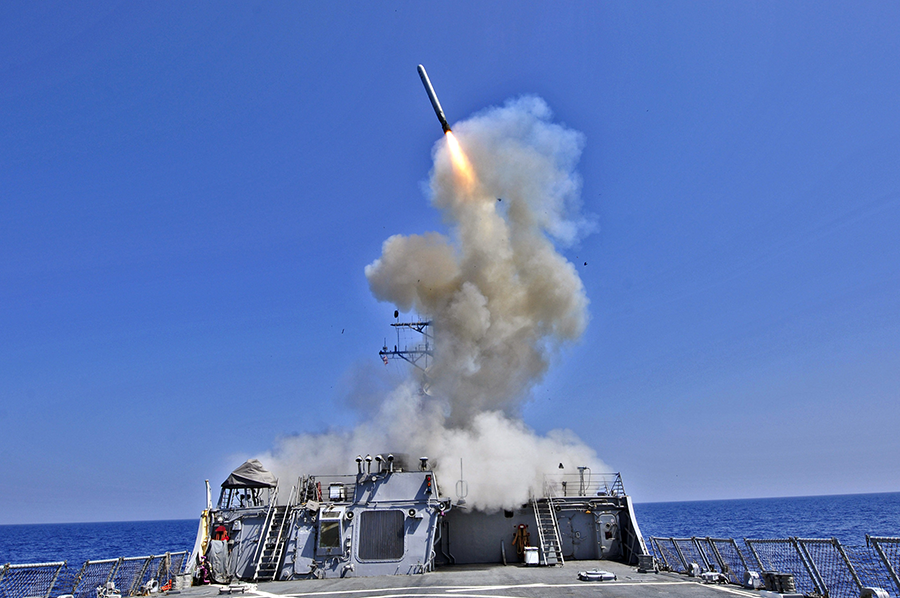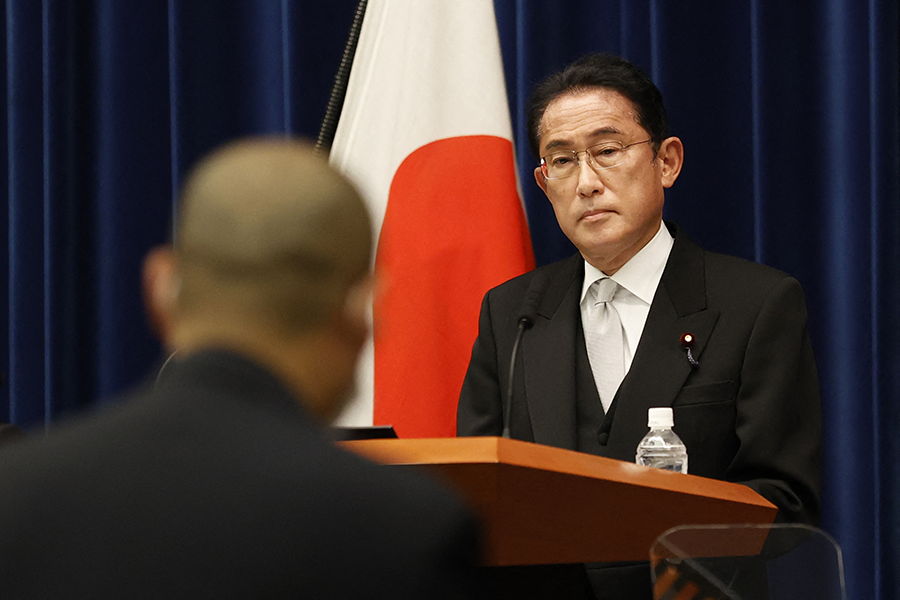“For half a century, ACA has been providing the world … with advocacy, analysis, and awareness on some of the most critical topics of international peace and security, including on how to achieve our common, shared goal of a world free of nuclear weapons.”
Japan’s Shift to a More Robust Self-Defense Policy
June 2023
By Yuki Tatsumi
On December 16, 2022, Japan released three key strategic and defense planning documents that changed its postwar security policy considerably.
With new commitments to nearly double defense spending and acquire counterstrike capabilities, Japan is stepping out of its decades-old approach to national security policy, particularly in defense policy. The defense policy has shifted from a postwar baseline of possessing just enough defensive capability to prevent a power vacuum from emerging in East Asia to one that aims to respond to specific threats.
 Taken together, the revised National Security Strategy, National Defense Strategy, and Defense Buildup Plan embody the considerable evolution of Japan’s threat perceptions in the last decade and its impact on national security policymaking. Given the security environment in Northeast Asia and the broader Indo-Pacific region, the policy trendline that was set in these documents likely will continue at least for the next decade as Japan works to overcome formidable challenges and actualize its goals.
Taken together, the revised National Security Strategy, National Defense Strategy, and Defense Buildup Plan embody the considerable evolution of Japan’s threat perceptions in the last decade and its impact on national security policymaking. Given the security environment in Northeast Asia and the broader Indo-Pacific region, the policy trendline that was set in these documents likely will continue at least for the next decade as Japan works to overcome formidable challenges and actualize its goals.
A Turn for the Worse
Japan embarked on its policy revision as it perceived that the regional security environment had taken a turn for the worse. The biggest driving force is the emergence of China as an economic behemoth and an increasingly aggressive military power that does not hesitate to flex its muscle. China began to outspend Japan on defense in the mid-2000s, and the gap between their military budgets has been widening ever since. Based on the defense budget that was unveiled at the Chinese People’s Congress meeting in March 2023, Beijing in fiscal year 2023 plans to spend approximately $224.8 billion, which is 4.5 times larger than Japan’s defense spending in the same year.1
Also affecting Japan’s threat perception is the extension of China’s increasingly aggressive behavior beyond Japan’s immediate vicinity into the South China Sea. In Northeast Asia, this has been demonstrated by the greater frequency of Chinese military aircraft entering Japanese airspace and the heightened activity of Chinese coast guard, military, and other governmental vessels in the East China Sea. Beijing’s increasingly robust approach toward Taipei also has worsened Tokyo’s concerns. Tensions ramped up particularly after U.S. House Speaker Nancy Pelosi visited Taiwan in August 2022 and China conducted a military drill in the Taiwan Strait.
A renewed intensification of North Korean missile provocations further added to Japanese security concerns. In 2022 alone, North Korea conducted 37 missile tests, firing more than 90 missiles. Of these missiles, 66 were ballistic missiles; and one test involved the firing in October of the Hwasong-12 intermediate-range ballistic missile, which triggered the J-ALERT, Japan’s nationwide missile warning system, for the first time in five years. North Korea exhibited intercontinental ballistic missiles and the operating units for its nuclear weapons in a military parade in February 2023. Two months later, it test-fired another ballistic missile that again triggered the J-ALERT warning system.
Russia’s full-scale invasion of Ukraine in February 2022 only deepened Japan’s concern for its security environment. It marked the first time in modern postwar history that a permanent member of the UN Security Council launched a war against another UN member state and served as a rude awakening for Japan, injecting policymakers in Tokyo with a cold dose of reality as they deliberated Japan’s options for its response. In particular, the Ukrainians’ clear and unambiguous will to defend their country and the international community’s collective backing for Ukraine reminded Japan that if its own territorial integrity comes under attack, it must demonstrate a similar credible will to defend itself in order to gain international support.
More importantly, Japan realized that it needs to develop the means to defend itself effectively from external aggression. Russia’s failure to secure an immediate victory over Ukraine, due in large part to weak supply lines and logistical capabilities, heightened Japan’s concern about the lack of investments in its own logistical capacity and, even more acutely, in the resiliency of the Japan Self-Defense Force.
Finally, the Russian-Ukrainian war exposed a reality in the international system, namely that the UN Security Council is limited in its ability to enable collective action when one of its permanent members is a party to the conflict. The inability of the United Nations to collectively respond to the Russian invasion of Ukraine was a fresh reminder of the importance of universal norms and principles, such as the rule of law. It also encouraged Japan to double down on its advocacy for UN reform, particularly reform of the Security Council.
The U.S. Factor
Although less openly discussed, the volatility of U.S. foreign policy during President Donald Trump’s administration shook Japan’s confidence in the durability of U.S. leadership in the world. Japanese-U.S. relations remained stable during that era, due to Japanese Prime Minister Shinzo Abe’s tireless effort to cultivate a personal relationship with Trump. Nonetheless, Japan perceived the United States as turning inward and relinquishing its leadership role in upholding the norms and values undergirding the international order.
 In particular, U.S. foreign policy choices that were based predominantly on reciprocity and a transactional approach toward U.S. allies and partners made Japanese policymakers question whether Tokyo could continue to count on Washington as a reliable ally in the long term. As a seasoned Japanese observer of U.S. foreign policy put it, “[I]f it turns out that what we saw during the Trump administration is not an anomaly but rather can easily come back in the future, we really ought to start thinking about ‘Plan B,’ which is a world where Japan may not be able to count” on the United States.2
In particular, U.S. foreign policy choices that were based predominantly on reciprocity and a transactional approach toward U.S. allies and partners made Japanese policymakers question whether Tokyo could continue to count on Washington as a reliable ally in the long term. As a seasoned Japanese observer of U.S. foreign policy put it, “[I]f it turns out that what we saw during the Trump administration is not an anomaly but rather can easily come back in the future, we really ought to start thinking about ‘Plan B,’ which is a world where Japan may not be able to count” on the United States.2
Such developments encouraged Japanese policymakers to revise Tokyo’s three strategic security documents from the perspective of “what Japan needs to do better to defend itself.” Daily exposure to news about the Russian-Ukrainian war, Chinese military aircraft incursions into Japanese airspace, and North Korean missile tests facilitated governmental deliberations by creating an atmosphere that allowed Japanese officials to consider policy options that had been long considered taboo. Such options included the need for defense spending increases and the acquisition of counterstrike capabilities. Russia’s attempt to intimidate NATO countries by hinting at the potential use of nuclear weapons even resulted in a temporary resurgence of a debate over Japan’s nuclear future.
Modernizing Japan’s Approach
The end result was that the three documents collectively modernized Japan’s national security and defense policies. They were shaped by the assessment that China is Japan’s primary national security concern for at least the next decade. The National Security Strategy identified China as “the greatest strategic challenge in ensuring the peace and security of Japan and the peace and stability of the international community, as well as in strengthening the international order based on the rule of law.”3
This is a notable departure from Japan’s past approach, in which it sought to strike a balance between calling China out for bad behavior while trying to engage the Beijing government in other areas. For instance, even when discussing in detail Chinese behavior that causes concern, Japan’s 2013 security strategy still mentioned an expectation that China would act responsibly and that its behavior, as problematic as it might be, was something that Japan needed to “pay careful and close attention to.”4
The new strategy documents also put Japan on a path to acquire new defense capabilities, including some that were unthinkable a decade ago. One example is Japan’s commitment to acquire counterstrike capabilities that include an initial purchase of several hundred U.S.-produced Tomahawk missiles. Although the defense strategy document takes pains to put this decision in the context of national defense, it previously was simply out of the question for Tokyo to even consider such capabilities, let alone proceed with acquiring them.
Contrary to past plans in which heavy emphasis was placed on the “efficient use,” i.e., cost-cutting, of the acquisition budget, the new defense buildup plan openly acknowledged for the first time that industries need incentives, otherwise known as business profits, to stay in the defense-related business and produce equipment that is critical for Japan to revitalize its indigenous defense industrial base. Tokyo’s commitment to increase defense-related spending by approximately 2 percent of its gross domestic product, or a total of roughly $320 billion over the next five years,5 is another example of how the country is shattering politically self-imposed constraints in its postwar national security policy.
The three documents also embrace a broader definition of national security. In particular, the focus on economic security in the national security strategy is noteworthy because it centered not only on critical economic issues, such as supply chain resilience, but also on economic issues that have long been neglected, such as safeguarding the procurement of critical infrastructure and protecting critical infrastructure locations, data, information, and industrial security.
The new policies also acknowledge that rapid progress in developing advanced technologies has blurred the line between “offense” and “defense” in the military context and between technologies suited for civilian and military use. More broadly, such recognition has facilitated a discussion among Japanese officials about advocating an all-of-government approach to shaping effective responses in the areas of economic security, space, and cybersecurity.
Overall, the new national security documents seek to provide an answer as to how Japan must reshape and modernize its security and defense policies to meet a rapidly changing threat environment. Notably, the policies pay overdue attention to the areas that have long deserved greater consideration, such as investments in force protection, logistical support capacity, military medicine, and ammunition shortages.
The Challenges Ahead
 Nevertheless, Tokyo faces formidable challenges in achieving the desired results, with resourcing as the biggest hurdle. Although Japanese Prime Minister Fumio Kishida directed the government to identify ways in which it could secure increased defense spending in a sustainable manner, the public is ambivalent at best. Given Japan’s weak fiscal condition, some type of tax increase, whether individual income taxes, consumption taxes, corporate taxes, or a combination, coupled with spending cuts in nondefense programs, inevitably will be required to finance a rise in defense spending. An opinion poll by Niohn Hoso Kyokai in February 2023 shows that the public is evenly split on whether to support higher defense spending. It also shows that close to 65 percent of the respondents oppose using a tax increase to finance bigger defense budgets. Without public backing, it is questionable that the government could find a path to increase the defense budget in a sustainable manner.
Nevertheless, Tokyo faces formidable challenges in achieving the desired results, with resourcing as the biggest hurdle. Although Japanese Prime Minister Fumio Kishida directed the government to identify ways in which it could secure increased defense spending in a sustainable manner, the public is ambivalent at best. Given Japan’s weak fiscal condition, some type of tax increase, whether individual income taxes, consumption taxes, corporate taxes, or a combination, coupled with spending cuts in nondefense programs, inevitably will be required to finance a rise in defense spending. An opinion poll by Niohn Hoso Kyokai in February 2023 shows that the public is evenly split on whether to support higher defense spending. It also shows that close to 65 percent of the respondents oppose using a tax increase to finance bigger defense budgets. Without public backing, it is questionable that the government could find a path to increase the defense budget in a sustainable manner.
Furthermore, demographic trends could complicate Tokyo’s effort to buttress national defense capabilities. According to Japanese government statistics, nearly 30 percent of the country’s population was over 65 years old in the fall of 2021, and by 2065 that aging group will account for nearly 40 percent of the population. In the face of this demographic reality, how to sustain the Japan Self-Defense Force at its current size is a question that, at the moment, no one can answer. Although two of the strategy documents stress the significance of better utilizing unmanned technologies to relieve some of the pressure that will come from the aging population, it is difficult to maintain a robust fighting force when nearly half of the country’s population is at retirement age or older.
As it wrestles with these challenges, Japan needs a strong leader with a clear vision to complete the national security transformation that has now been outlined. Given the absence of a visionary such as Abe, its successful implementation is anything but certain. Although Kishida, with his image as a moderate and a consensus builder, may have been the right person at the right time to complete the revision of the three documents, it is uncertain whether he has the political gravitas to inspire the Japanese people and rally them behind the execution of his vision.
ENDNOTES
1. “Chugoku Kokubou-hi 30-chou yen amari, Kyonen yori 7.2% zouka de Gunbi Zoukyou Shisei shimesu” [China’s defense spending approximately JPY 30 trillion, 7.2% increase compared to last year, demonstrating the will to strengthen its military], Nihon Housou Kyoukai, March 5, 2023, https://www3.nhk.or.jp/news/html/20230305/k10013998901000.html#:~:text=2016%E5%B9%B4%E4%BB%A5%E9%99%8D%E3%81%AE%E4%BC%B8%E3%81%B3,%E3%81%BB%E3%81%A9%E3%81%AB%E3%81%AA%E3%81%A3%E3%81%A6%E3%81%84%E3%81%BE%E3%81%99%E3%80%82.
2. Senior Japanese foreign policy correspondent, conversation with author, Tokyo, April 28, 2023.
3. Government of Japan, “National Security Strategy of Japan,” December 2022, https://www.mod.go.jp/j/policy/agenda/guideline/pdf/security_strategy_en.pdf.
4. Government of Japan, “National Security Strategy,” December 17, 2013, https://japan.kantei.go.jp/96_abe/documents/2013/_icsFiles/afieldfile/2013/12/18/NSS.pdf.
5. “Defense Buildup Plan,” December 16, 2022, https://www.mod.go.jp/j/policy/agenda/guideline/plan/pdf/program_en.pdf.
